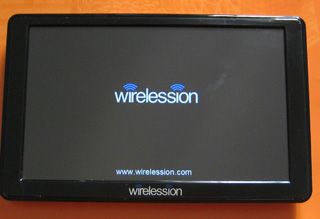News about the Camangi Webstation has been around for a while and it’s been interesting to watch the company ramp up their marketing from a fuzzy introduction in October to a smart-looking website today. The product looks quite slick too but is it going to work? I have a few reservations and am suspicious that this the Webstations is more marketing than product.
We’ve seen 7 inch resistive touchscreen devices many times before. The Samsung Q1 Ultra was a good example. The current Viliv X70 too but these were using (by necessity) a Windows desktop environment. They work well for people wanting a full mobile desktop experience with full driver support, high-end browser and desktop application capability but for the casual consumer of web and media, they are a bit OTT. The user interface isn’t fun and battery life issues mean you have to keep them turned off if you want to preserve battery life. They just aren’t set-up for the average internet snacker. The Camangi Webstation appears to offer a much more consumer-focused solution. The weight, price, style and operating system are all tuned towards coffee-table, sofa and casual, mainly home or holiday-based, internet activities.



Full gallery at UMPCPortal Also at Camangi website.
390grams is a good one-handed weight (anything over 500gm can feel awkward after 20 minutes) and the price, which is rumored to be $399, is far more palatable than the $600-$800 that you pay for a Windows-based ultra mobile PC but it’s the Android operating system that really tilts the device towards the consumer. It’s touchscreen-friendly, tailored towards the casual user rather than the productive professional and is infinitely customizable with icons, widgets and applications.
So how is this baby going to perform? The speed of the browser, quality of media playback, ability for applications to run concurrently and the battery life are going to be critical.
Taking a look at the battery specifications and using a lot of experience I’ve had with testing devices (and interpreting marketing figures) tells me that we’re looking at a device that will allow you to browse the web for under 4 hours over Wifi. The large screen backlight will be taking a lot of juice and web-sites can be very heavy-weight CPU consumers. The nice thing about using a low-power ARM platform is that if you close all the apps, the device will sit around for a day or two and be ready to jump into action within seconds. Screen-off activities like music playback will also run into the 10+ hours range making it a nice addition for the home hifi.
As far as performance goes, this is where I have my reservations. The CPU in this device is not exactly leading-edge and with about 1/2 the processing power of top-end smartphones (estimated 1/5th of the processing power of a netbook) , browsing speeds could be somewhat laggy. Media playback performance could be limited too. Granted, the need for speed isn’t as great when you’re lying back in a comfy chair but in my opinion, the performance isn’t going to match the marketing that we’re seeing and there could be disappointment. I’ve tested a very similar device, the SmartQ7, and I can’t honestly say that it was a thrilling experience. Regardless of operating system if YouTube doesn’t work or programs hang for too long, it’s frustrating.
Full specifications.
You can find more information and marketing materials on the Camangi website.
Size and weight
- Height: 4.72 inches (120mm)
- Width: 7.87 inches (200mm)
- Dipth: 0.57 inches (14.5mm)
- Weight:13.75 ounces
(around 390 grams)
System
- Google Android 1.5
- CPU: Marvell PXA303 624MHz
- System memory: 128MB Mobile DDR
- Flash memory: 265MB NAND (system)
- Input: Software keyboard; USB keyboard support
Display
- 7-inch TFT LCD, 16M True Color
- Single Resistive touch panel with hard glass
- High-resolution screen, 800-by-480 pixels
- G-sensor
Power and battery
- Built-in rechargeable Lithium Polymer battery (3.7V 4000mAh)
- Standby time: up to 4 days(without GPS & Wi-Fi connection); Internet and media use: up to 4-5 hours
- Power charging: 5V 3A DC in
Communication
- Wi-Fi (802.11 b/g)
- USB dongle to 3G connectivity*
- GPS module
*Note: Only applicable for some type of 3G dongle devices
Connectors and input/ output
- Built-in speaker (80hm 2x 1W)
- 3.5mm stereo headphone jack
- AC Adaptor, 4mm DC in
- Built-in omni-directional microphone
- Micro SD card slot, supports 1G~16G
- Type A & mini-B USB port
Summary.
Camangi are moving in the right direction. The style, choice of operating system and pricing are positive points but I’m a little worried that the limited CPU, RAM and the resistive touchscreen will disappoint customers. Upgrade to the latest CPU platform and drop 256MB of RAM in there and it would stand a better chance. Camangi also need to watch their competitors too. A 5 inch Archos 5 with Android with an 800Mhz ARM Cortex CPU (the latest and greatest) already provides a smooth experience at a lower price and if you’re looking for a 7 inch device, the Wirelession W1060 offers a similar high-end performance at just $250.
We’re going to hold off from putting this into the database until we can confirm that it’s not just a pretty face.















